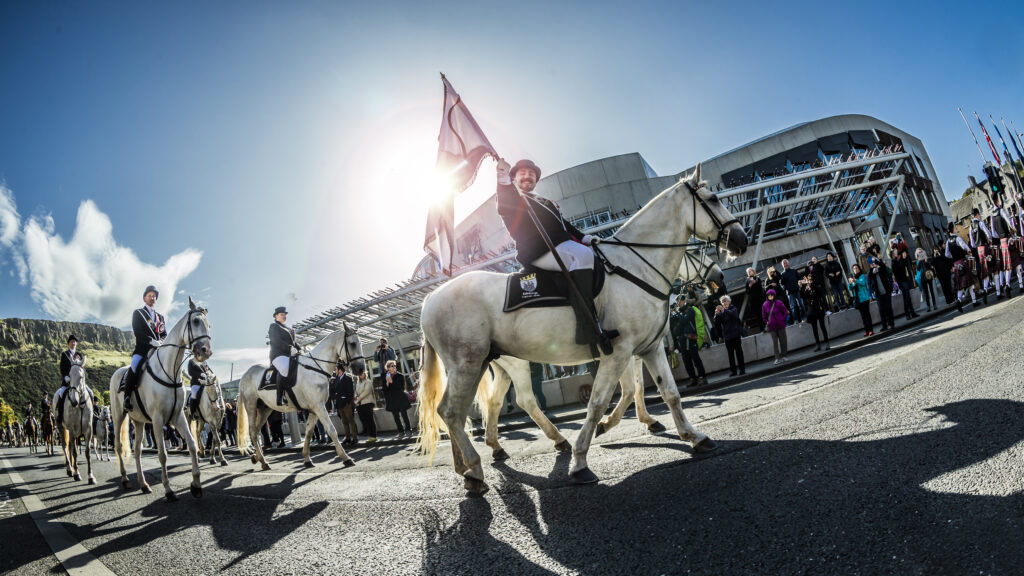
The Incorporated Trades of Edinburgh join the cavalcade on the Royal Mile for the Edinburgh Riding of the Marches, leading the horses to the Mercat Cross, attended by the Lord Provost, Lord Dean of Guild and the Deacon-Convener of Trades, all in their full robes and chains of office.
All of the Incorporated Trades are represented at the Mercat Cross, opposite the City Chambers, proudly carrying their banners in the procession. In 2013 there was a special commemoration for the 500th anniversary of the Battle of Flodden. In 2014 the event being commemorated was the centenary of the outbreak of the First World War. On both those occasions there was a minute’s silence for the fallen, during which the banners were dipped in reverent salute and a lone piper played the well-known lament, The Flowers o’ the Forest.

The incorporations were and are trade organisations whose members are or were “craftsmen” or “tradesmen” manufacturers, known as “freemen masters” of their particular trade. The incorporations perform the same functions in Scottish burghs as the worshipful companies do in London, but none are as large or as well-endowed as their English counterparts. The freemen of the incorporations, who historically were all supposed to be burgesses of the burgh, were expected to employ journeymen and to train apprentices. Today the nature of most of the incorporations has changed and the freemen are often professionals in some field other than that to which their incorporation pertains.
Until the Scottish Burgh Reform Act in 1833 six of the deacons of these incorporations were full members of the Town Council (usually called “council deacons”) and the remaining eight were denominated “extraordinary deacons”, who sat with the Council on certain occasions and had voice and vote in the annual municipal elections. Until 1846 the incorporations exercised exclusive privileges of trade, preventing any outsiders from practising their craft in the burgh until they had paid their dues and joined the appropriate incorporation.
There were fifteen incorporations in Edinburgh, fourteen of which had deacons who were permanent members of the Convenery of Trades from its inception in c.1562. The deacon of the Candlemakers was only included in the Convenery for a short time, from 1598 to 1604; since 2011 he has been included oncemore. The Society of Barbers did not come into existence until it separated from the Surgeons in 1722.
The order of precedence among the incorporations is determined not by their relative antiquity but by the Act of Sett of the Burgh of Edinburgh, which was agreed by King James VI in a decreet arbitral in 1583. Part of the reason for this is that by that time several of the trades, most of which were a century or more old, no longer possessed their original seals of cause and did not know the year in which they had been founded.

The Trades of Edinburgh:
1. The Incorporation and Royal College of Surgeons
2. The Incorporation of Goldsmiths
3. The Incorporation of Skinners
4. The Incorporation of Furriers
5. The Incorporation of Hammermen
6. The Incorporation of Wrights
7. The Incorporation of Masons
8. The Incorporation of Tailors
9. The Incorporation of Baxters
10. The Incorporation of Fleshers
11. The Incorporation of Cordiners
12. The Incorporation of Weavers
13. The Incorporation of Waulkers
14. The Incorporation of Bonnetmakers & Dyers
15. The Incorporation of Candlemakers
The Society of Barbers

Convenery of Edinburgh
The Convenery of the Trades of Edinburgh consists of the deacons of all the incorporated trades, who meet together regularly for the mutual benefit of incorporations. Any Deacon unable to attend is expected to send a proxy to stand in for him or her.
The Convenery was formed just after the Reformation in about 1562 with the aim of combining the strength of the trades in the Town Council and in the city in general, to combat the power of the merchants of the burgh. In the broadest sense of the term the Convenery may be looked upon as embracing all the freemen and freewomen of all the incorporations, their deacons merely forming a committee of management. Any member of an incorporation has the right to appear before the deacons to have a petition heard or a grievance settled. In the 21st century the Convenery continues to look after the interests of the incorporations and their freemen and members. It co-ordinates many of their activities, such as the Kirking of the Deacons (usually the first week in May) and the Riding of the Marches (early September). It also administers the Trades Maiden Fund, which was founded by the Trades of Edinburgh and Mary Erskine in 1704 to promote girls’ education.
Deacons ceased to form part of the Town Council in 1833 and further privileges were lost in 1846. Since then, the Convenery has continued to play an important role in controlling the crafts and helping them when required. At the present time the Convenery helps to co-ordinate the activities of the incorporations, including the Kirking of the Deacons (usually the first week in May) and the Riding of the Marches (early September), when the banners of all the incorporated trades are carried in procession. It also administers the Trades Maiden Fund, which was founded by the Trades of Edinburgh and Mary Erskine in 1704 to promote girls’ education. The Convenery is headed by Ian Robertson, the Deacon-Convener of the Trades of Edinburgh, who has the distinction of being the first tradesman in Scotland. He also takes precedence among the citizens of Edinburgh in third place, after the Lord Provost and the Lord Dean of Guild.
You can read more about The Incorporated Trades of Edinburgh on their website.
